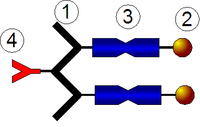
Photo from wikipedia
Sugar chain immobilized polymer particles having both magnetic and fluorescent properties can be expected to be useful in a wide variety of biomedical applications such as the detection, separation, and… Click to show full abstract
Sugar chain immobilized polymer particles having both magnetic and fluorescent properties can be expected to be useful in a wide variety of biomedical applications such as the detection, separation, and purification of proteins, viruses, or bacteria, because sugar chains specifically adsorb them. Since high magnetic responsiveness is required for such applications, we attempted to fabricate core-shell particles consisting of a submicron-sized magnetic core and a thin polymer shell (nano- to dozens of nanometers thick) that incorporates a fluorescent dye, with sugar molecules immobilized on the surface. Soap-free emulsion polymerization using methyl methacrylate (MMA) monomer and potassium persulfate (KPS) initiator in the presence of aminopropyltrimethoxysilane-treated Ni particles, octyl-β-D-glucopyranoside (octyl-glc), and rhodamine B (RhB) produced a glucose-immobilized fluorescent PMMA thin shell on a Ni particle (Ni/PMMA/RhB/octyl-glc). Electrostatic interaction was used both to incorporate RhB into the PMMA shell and to coat the Ni core with the PMMA-RhB shell. Glucose was immobilized on the PMMA shell by embedding a hydrophobic octyl group derived from octyl-glc in the PMMA matrix, and the resulting sugar-immobilized PMMA shell was able to adsorb protein (concanavalin A; a protein that specifically adsorbs glucose). The resulting Ni/PMMA/RhB/octyl-glc particles were well-dispersed in water, detected by highly sensitive fluorescence techniques, and could be collected by a magnet within 10 sec. They are expected to be applied to detect biological substances such as various proteins and viruses by changing the glucose moiety of the particle surface to other functional glycans.
Journal Title: Colloid and Polymer Science
Year Published: 2022
Link to full text (if available)
Share on Social Media: Sign Up to like & get
recommendations!